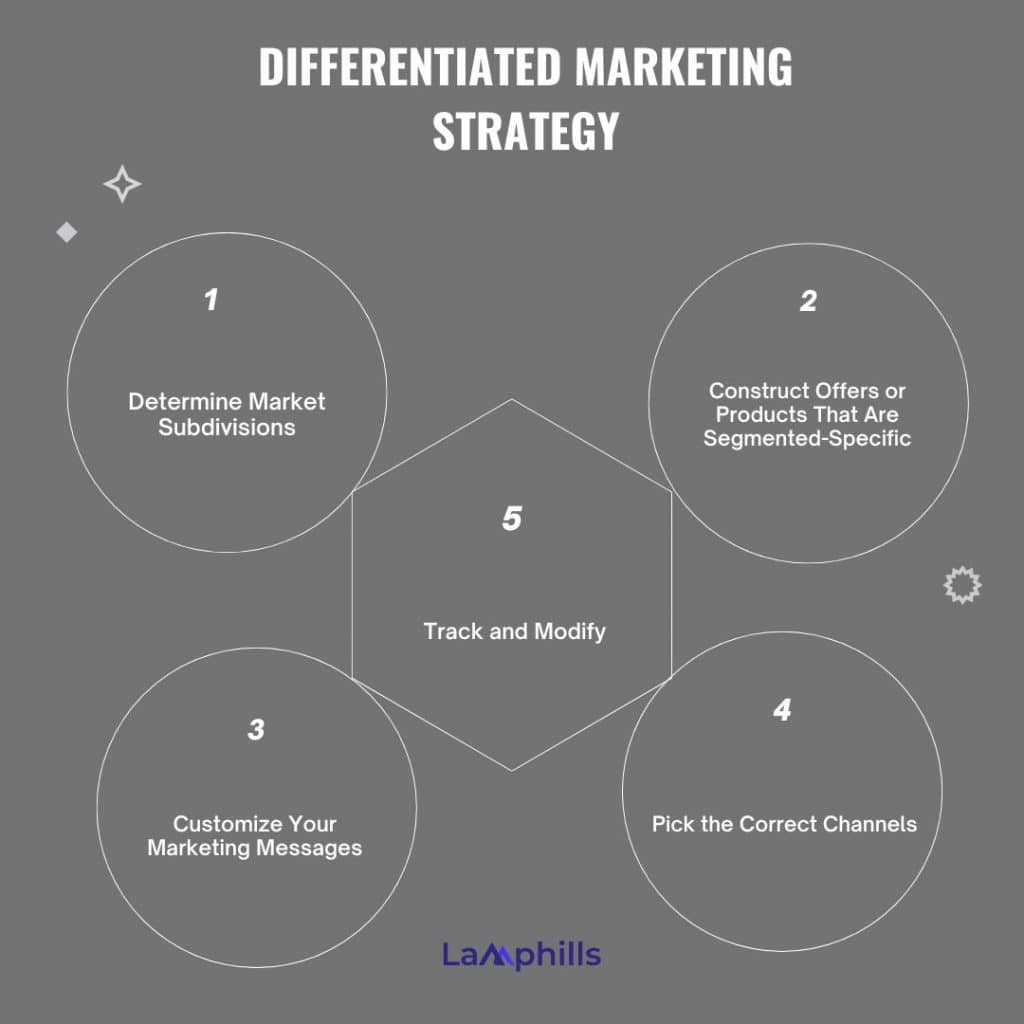The field of marketing is dynamic and always changing to meet the demands, preferences, and behaviors of its customers. Among the most effective tactics used by brands to satisfy the varied demands of their target markets is differentiated marketing. I didn’t realize how important this method was until I was deep in a commercial venture that made me face the diverse wants of my clientele. For my business, the secret to growth and stronger client relationships was putting a differentiated marketing plan into practice. This article will discuss my own experience with differentiated marketing, define it, and offer insights into why it’s so revolutionary for businesses; however, I’ll also provide real-world examples along the way, including my own, of how the strategy might be used successfully.
Key Points
- Businesses can differentiate themselves from rivals by providing clients with distinctive, customized experiences through differentiated marketing.
- By catering to your individual wants and preferences, differentiated marketing enables companies to establish connections with a variety of clientele.
- Offering individualized goods and communications can help companies boost customer engagement and boost revenue.
- Customers are more likely to return and show brand loyalty when they feel valued and understood.
- It is possible to make better use of resources by concentrating efforts where they have the greatest impact by targeting particular segments.
What Is the Meaning of Differentiated Marketing?
A corporation that uses differentiated marketing, sometimes referred to as multi-segment marketing, targets various market segments with customized advertising campaigns. Differentiated marketing acknowledges the requirements and preferences of many consumer groups rather than presenting a single product or message to the whole market. Companies design marketing messages and goods that appeal to each market niche.
My first business was a little online store selling home décor items, and when I started it, I realized that a one-size-fits-all marketing strategy wasn’t working. At first, I made generic emails and social media ads that I assumed would be liked by everyone. The outcomes, however, were unsatisfactory. Sales were slow to come in, and engagement was low. I thought my efforts were disorganized and lacking something.
One of my close marketing friends advised me to do a more thorough analysis of my clientele. Upon examining my analytics, I saw that my readership was divided into many groups. In addition to younger tenants on a tight budget who had an eye for stylish yet reasonably priced décor, some homeowners were searching for upscale, handcrafted goods. I then understood the need for differentiated marketing and realized that I needed to stop treating every member of my audience in the same manner.
Also Read: The Essentials of Effective Integrated Marketing Campaign + Templates
What Makes Differentiated Marketing Vital?
Through differentiated marketing, companies can establish a stronger bond with their clientele. You may address the distinct requirements, preferences, and issues of particular segments by crafting communications that are specifically tailored to them. This promotes client loyalty and raises the chance of conversion. Ultimately, who doesn’t value a brand that talks to them directly?
After identifying the different divisions of my clientele, I began modifying my marketing tactics accordingly. For wealthy consumers, I created sleek, smart ads that highlighted the limited availability and craftsmanship of specific products. Using lighthearted language and imagery, I emphasized affordability and style for the younger, cost-conscious audience. My earlier wide strategy failed to impact consumers as much as these tailored campaigns did.
I saw a spike in social media interaction almost instantly. Posts started receiving comments from customers who expressed their admiration for the distinctive designs and affordable costs. Since the correct products were being sold to the right people, sales also increased.
Differentiated Marketing Strategy
Developing a unique marketing approach is a science and an art. The stages I took are listed here, along with some observations I made about the process:
#1. Determine Market Subdivisions
Understand your audience as a first step. Are they who? What kinds of things do they like? Tools like analytics, market research, and customer surveys are useful in this situation. Google Analytics was my first tool for audience segmentation based on demographics and activity. I observed trends, such as younger individuals using mobile devices to browse in the evenings and older folks preferring to use desktop computers to browse during the day. I also polled clients to find out what they valued most in home décor, their buying habits, and their preferences.
#2. Construct Offers or Products That Are Segmented-Specific
Ensuring your messaging and product offerings are appropriate for each category is the next step after segmentation. I started offering different product lines to accommodate different customer groups. High-end consumers were treated to limited-edition, handcrafted pieces, while those on a tighter budget were given trendy, mass-produced goods that were still fashionable but more reasonably priced. By differentiating their product ranges, both markets felt taken care of.
#3. Customize Your Marketing Messages
It is equally important to differentiate the marketing message from the product. Advertisements, emails, and promotions that target each segment’s needs should be sent to them. Each component had its own advertising that I developed. The advertisements, which had a smart tone and simple, minimalist graphics, catered to high-end consumers and highlighted the exclusivity and distinctiveness of the products. For the younger, fashion-forward audience, I emphasized affordability and current trends with lively, engaging images and language.
#4. Pick the Correct Channels
There are preferred routes of communication for each customer category. Others may be more engaged on social media, while others might prefer email. Finding the topics that most interest your audience will help you improve the success of your marketing initiatives. In my experience, younger audiences were more active on Instagram, but the older, wealthy demographic responded favorably to email marketing initiatives. I was able to better organize my marketing resources as a result of this discovery, concentrating my email efforts on one group while increasing social media involvement for the other.
#5. Track and Modify
Marketing that is differentiated is a continuous process. Consumer demands change over time, so what works now might not work tomorrow. Because of this, it’s critical to repeatedly assess each segment’s performance and modify your approach as necessary.
I eventually mastered the use of analytics to monitor the effectiveness of my ads. Since some campaigns were more effective than others, it was critical to modify the offer or tone in response to immediate feedback.

Examples of Differentiated Marketing
These cases have been on my mind because they show how creative differentiation marketing can reach a broad audience without compromising brand uniqueness. I have personally encountered the following examples of differentiated marketing, each of which demonstrates how companies can modify their approaches for various target audiences:
#1. Apple
Offering items for a variety of needs has allowed Apple to perfect distinct marketing. While those seeking a more cost-effective choice are drawn to the iPhone SE, the iPhone Pro caters to those in the tech sector who demand the newest and greatest. They have similar models of laptops: the MacBook Air is small and ideal for students, while the MacBook Pro is for professionals who require more power for creative work. Since every product caters to a distinct consumer type, Apple is available to a large audience.
#2. Coca-Cola
The way Coca-Cola markets various goods to various demographics has always caught my attention. The Coca-Cola brand is a well-known illustration of distinct marketing. With a range of products, including Coca-Cola Classic, Diet Coke, Coke Zero, and Coca-Cola Life, the corporation caters to distinct market niches. Coke Classic is marketed to soda drinkers in general, Diet Coke to those who wish to reduce their sugar intake, Coke Zero to those who prefer a calorie-free option, and Coca-Cola Life to those looking for a natural sweetener for health-related reasons. Every product has its personality and meets the needs of different types of consumers.
#3. Nike
Another company that caught my attention for its strategy is Nike. They target various individuals according to their interests; they do more than just sell shoes. For example, Nike Air Jordans appeal to sneakerheads and basketball fanatics, while Nike Women encourages women’s empowerment and fitness. Next is Nike SB for skaters, which demonstrates how the company targets particular demographics with its marketing while maintaining its essential athletic image.
Similar strategies were used by my online store, which introduced distinct product lines for various customer demographics. Even though I was not as accessible as in the aforementioned cases, I was able to observe personally the effect of uniqueness. Offering specialized product lines for different demographics allowed me to boost overall sales and customer satisfaction.
Different Types of Differentiated Marketing
Numerous target audiences can be reached via differentiated marketing using a range of different strategies. Use market research to see how your brand might appeal to various buyer types. I was able to increase interaction across several segments and target particular groups with these kinds of specialized marketing. The following is a brief explanation of the primary forms of differentiated marketing:
#1. Differentiation Channels
Using their preferred platforms to reach various client segments. I discovered, for instance, that some clients responded better to email marketing, while others preferred to interact on social media. My ability to adapt the message to each medium improved my ability to engage with various audiences.
#2. Differences by Geography
Targeting clients according to where they live. Offering regionally tailored items or promotions based on the location of your audience is one example. I used to modify my products for local markets because I knew that regional preferences and needs differed.
#3. Differentiating Services
Companies could modify their marketing plans to cater to different visitor categories with different offers. For instance, February might be the best month to advertise holiday marketing deals for couples at different price points, such as free champagne on Valentine’s Day or suite upgrades. A hotel might advertise packages for social gatherings that include buffet meals or unlimited drinks to coincide with college student’s spring break.
#4. Product Differentiation
This entails developing distinct product versions to cater to different clientele. Offering a luxury product line to high-end consumers and a more affordable one to people on a tight budget is one example. For example, I had expensive home décor pieces for one group and fashionable, reasonably priced designs for another.
#5. Price Differentiation
Modifying pricing plans according to client categories. Different groups may be eligible for premium pricing or discounts from a firm. For instance, I used to provide student discounts to draw in younger customers while maintaining standard prices for the remainder of the audience.
#6. Differentiating Images
When thinking about how a brand would wish to sell itself, it could benefit from setting itself apart through its positioning and image. Businesses should consider the best way to show themselves to their target audience, whether that means promoting themselves as a sustainable business, emphasizing their involvement in the community or around the world, or presenting themselves as a more upscale or accessible choice. As a business group, it should consider how to effectively tailor the steps to position a brand’s goods or services.
The Benefits of Differentiated Marketing
The strength of differentiation was established and my company outcomes were much enhanced by these advantages. The following are:
#1. Better Relationships with Customers
By focusing on particular market niches, I was able to better connect with my clients and increase engagement.
#2. An Increase in Sales
Customers who believed that the products were tailored to their own needs were more drawn to personalized offerings.
#3. A Competitive Edge
My unique marketing strategy helped me stand out from the competition and draw in clients who desired a more individualized experience.
#4. More Brand Attraction
Consumers valued the fact that my brand was aware of their preferences, which encouraged repeat business and loyalty.
#5. Allocating Resources Efficiently
Targeting the appropriate channels for each group and concentrating on distinct groups helped me make better use of my marketing budget.
Difficulties with Differentiated Marketing
There are obstacles to overcome while using differentiated marketing. It takes more resources than a general strategy because every sector needs different channels, messaging, and product offerings. Additionally, attempting to target too many categories at once always runs the danger of compromising your efforts.
At one time, I recall feeling overburdened by managing several campaigns for various target audiences. Managing things efficiently proved challenging, particularly for a small organization. I considered whether it was worthwhile at times. However, by carefully organizing my time and setting priorities, I was able to concentrate on the areas that were most important to my company.
Keeping my brand’s identity consistent across many campaigns was another difficulty. I had to make sure the messages were consistent with my beliefs and brand voice, even if they were customized. Perfecting this balance took time.
Also Read: Brand Marketing vs. Content Marketing: How They Differ and Work Together
What Is Differentiated Marketing?
A corporation that uses differentiated marketing develops advertising campaigns to target distinct customer segments. To put it another way, it’s similar to creating original ads that appeal to various audiences.
What Is an Example of Differentiation Marketing?
The Coca-Cola brand is a well-known illustration of distinct marketing. With a range of products, including Coca-Cola Classic, Diet Coke, Coke Zero, and Coca-Cola Life, the corporation caters to distinct market niches. Coke Classic is marketed to soda drinkers in general, Diet Coke to those who wish to reduce their sugar intake, Coke Zero to those who prefer a calorie-free option, and Coca-Cola Life to those looking for a natural sweetener for health-related reasons.
Conclusion
Differentiated marketing is a potent tactic that enables companies to meaningfully engage with various client categories. By customizing campaigns, messaging, and goods to each group’s specific requirements, businesses may boost engagement, foster loyalty, and eventually spur development. During my journey, I changed my business by implementing a unique marketing approach. What had begun as a generic marketing campaign that was struggling evolved into a more customer-focused business. Higher engagement and better outcomes were attained by comprehending the particular needs of my audience and developing campaigns that spoke to them personally. If you’re a marketer or business owner who wants to reach a wider audience and build stronger relationships with them, I strongly suggest adopting differentiated marketing. The outcomes are worthwhile, but they require work.
Related Articles
- The Advantages and Disadvantages of Undifferentiated Marketing: A Comprehensive Overview
- Penetration Pricing Strategy: 6 Advantages and Disadvantages of Penetration Pricing Strategy (+ Examples)
- Product Launch Press Release: How to Write With Examples
- Multichannel vs Omnichannel Marketing: How to the Right Strategy for Best Result
- SMART PR Goals: Examples & All You Need






